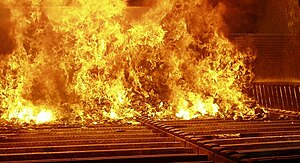 Image via Wikipedia
Image via Wikipedia
Energy is the driving force for development in all countries of the world. The increasing clamor for energy and satisfying it with a combination of conventional and renewable resources is a big challenge. Accompanying energy problems in different parts of the world, another problem that is assuming critical proportions is that of urban waste accumulation. The quantity of waste produced all over the world amounted to more than 12 billion tonnes in 2006, with estimates of up to 13 billion tonnes in 2011. The rapid increase in population coupled with changing lifestyle and consumption patterns is expected to result in an exponential increase in waste generation of upto 18 billion tonnes by year 2020.
Waste generation rates are affected by socio-economic development, degree of industrialization, and climate. Generally, the greater the economic prosperity and the higher percentage of urban population, the greater the amount of solid waste produced. Reduction in the volume and mass of solid waste is a crucial issue especially in the light of limited availability of final disposal sites in many parts of the world. Millions of tonnes of waste are generated each year with the vast majority disposed of in open fields or burnt wantonly.
Waste-to-Energy (WTE) is the use of modern combustion and biochemical technologies to recover energy, usually in the form of electricity and steam, from urban wastes. These new technologies can reduce the volume of the original waste by 90%, depending upon composition and use of outputs. The main categories of waste-to-energy technologies are physical technologies, which process waste to make it more useful as fuel; thermal technologies, which can yield heat, fuel oil, or syngas from both organic and inorganic wastes; and biological technologies, in which bacterial fermentation is used to digest organic wastes to yield fuel. Waste-to-energy technologies can address a host of environmental issues, such as land use and pollution from landfills, and increasing reliance on fossil fuels.
Around 130 million tonnes of municipal solid waste (MSW) are combusted annually in over 600 waste-to-energy (WTE) facilities globally that produce electricity and steam for district heating and recovered metals for recycling. Since 1995, the global WTE industry increased by more than 16 million tonnes of MSW. Incineration, with energy recovery, is the most common waste-to-energy method employed worldwide. Over the last five years, waste incineration in Europe has generated between an average of 4% to 8% of their countries’ electricity and between an average of 10% to 15% of the continent’s domestic heat.
Currently, the European nations are recognized as global leaders of the SWM and WTE movement. They are followed behind by the Asia Pacific region and North America respectively. In 2007 there are more than 600 WTE plants in 35 different countries, including large countries such as China and small ones such as Bermuda. Some of the newest plants are located in Asia.
The United States processes 14 percent of its trash in WTE plants. Denmark, on the other hand, processes more than any other country – 54 percent of its waste materials. As at the end of 2008, Europe had more than 475 WTE plants across its regions – more than any other continent in the world – that processes an average of 59 million tonnes of waste per annum. In the same year, the European WTE industry as a whole had generated revenues of approximately US$4.5bn. Legislative shifts by European governments have seen considerable progress made in the region’s WTE industry as well as in the implementation of advanced technology and innovative recycling solutions. The most important piece of WTE legislation pertaining to the region has been the European Union’s Landfill Directive, which was officially implemented in 2001 which has resulted in the planning and commissioning of an increasing number of WTE plants over the past five years.
